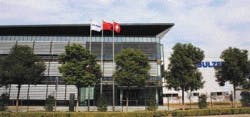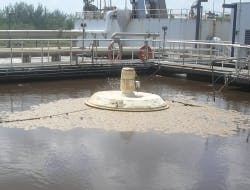The Case for Industrial Water Reuse - A Looming Necessity
By Peter S. Cartwright
• A growing imperative due to tighter freshwater resources globally requires getting over the 'yuck' factor in wastewater recycling -- both for municipal and industrial purposes.[Web Exclusive - Industrial WaterWorld - Sept. 1, 2009] -- Supporters of water reuse efforts globally find ever more validation in numbers. The total volume of water on this planet has remained largely unchanged for millions of years -- since the compound was first formed. Certain chemical reactions create water, such as those in internal combustion engines; however, water is also consumed in other chemical reactions, and small quantities of water vapor leak into the upper atmosphere and are lost to outer space.
On earth, 97% of the water is seawater. Of the remaining 3%, two-thirds is currently frozen as ice caps, glaciers and permanent snow. What's left is found in a variety of locations: over 98% of this freshwater is groundwater; 1.5% is lake water; less than 0.02% is river water and even less is atmospheric water.
Since total water supply hasn't changed and because of rapidly increasing global population -- which hit 6 billion in 1999 and is projected to reach 9 billion by 2030 -- there's increasingly a growing and serious shortage of good quality water available for human consumption, as well as for commercial, industrial and agricultural activities.
Plating Wastewater ReuseAn example by the author of an industrial water reuse application as outlined here is described in "Plating Wastewater Reuse -- An Innovative System Design" -- published in the first issue of the Membranes supplement (April 2008) to WaterWorld and Industrial WaterWorld. It addresses the reclamation and reuse of rinse water in an electroplating job shop, where the effluent from a traditional chemical wastewater treatment process is continuously treated to meet two purity requirements for rinsing applications within the facility.Other factors supporting the case for water reuse include:
• Steady migration of people into cites (increasing pressure on existing infrastructure).
• Increasing agricultural and industrial activities.
• Economic growth (as standard of living increases, so does per capita water usage).
• Recognition of new, health-related water contaminants, particularly microorganisms.
• Inability of current water treatment practices to adequately purify water on a large scale.
As a result, wastewater recycling is increasingly gaining importance.
Process Water Recovery
Water reuse is the general term applied to the act of recovering water from a process and reusing it in the same process, or another one. Today, there are virtually no technical barriers to water reuse, only economic and organizational commitment.
Industries, in general, have been poor stewards of water conservation. Most water brought into the plant is used only once, even though that use may have had very little impact on quality of the water. In most of the industrialized world, we've labored under the misconception that our water supply was inexhaustible as well as inexpensive. This cost aspect has been exacerbated by the fact that, in many areas, the price of water has been partially subsidized by local governments.
Undoubtedly, a paradigm shift is taking place with regard to water conservation and reuse, but any reluctance to incorporate reuse can usually be attributed to one or more of the following:
• The "yuck" factor, particularly in reusing biological wastewater or sewage.
• Insufficient knowledge of practical reuse technologies.
• Economic factors.
• Lack of commitment.
The mindset that embraces the concept of water reuse ensures that the facility has made a conscious decision to reclaim this water and has taken the required steps to:
1. Determine exactly what contaminants are present, along with their concentrations.
2. Determine the quality of water required for reuse.
3. Test and implement the optimum technologies to treat the wastewater for reuse.
Table 1. Waterborne contaminantsIndustrial Reuse Candidates
Sources of industrial wastewater that represent candidates for treatment and reuse go beyond processes within the facility. They also include rainwater and stormwater runoff. These are often overlooked, but represent excellent sources that are easy to collect, treat and reuse in applications such as landscape irrigation.
To properly address any water reuse operation, it's essential to understand the nature of waterborne contaminants. The universe of contaminants is almost endless, resulting from largely indiscriminant discharge of manmade contaminants (e.g., machine oils, industrial chemicals, pharmaceuticals and personal care products, etc.). Table 1 lists four classes of waterborne contaminants, and provides examples of each.
Table 2. Industrial water and wastewater treatment technologiesKey to water reuse is to have an arsenal of technologies available to efficiently remove hazardous or undesirable contaminants from the water supply. There's no single technology that sufficiently and economically removes all classes of contaminants; however, there are treatment technologies that, collectively, are capable of effectively reducing the concentration of virtually any contaminant down to acceptable levels for any water use requirement.
For industrial water and wastewater treatment, a plethora of technologies exist, each of which has its strengths and weaknesses in specific applications. A listing of these is provided in Table 2.
For industrial wastewater reuse, the lynchpins of these treatment technologies are the membrane separation technologies of reverse osmosis (RO), nanofiltration (NF), ultrafiltration (UF), and microfiltration (MF). Figure 1 illustrates these technologies.
By separating the treatment process into its key components: pretreatment, primary treatment and post-treatment, it's possible to design optimum technology trains that can purify the stream from virtually any source and condition it for any reuse application.
In the United States, an estimated 1.7 billion gallons (6,440,000 m³) of wastewater per day is currently reused and reclaimed. In fact, on a volume basis, reclaimed water use is growing at an estimated 15% per year.
Figure 1. Membrane separation technologiesMembrane Technologies
Because of their unique versatility and wide applications, membrane technologies are key processes in wastewater reuse applications.
The four membrane technologies in use today are MF, UF, NF and RO, which utilize pressure as the driving force. These technologies behave differently than filters in that (with some exceptions) the feed stream is continuously pumped at a high flow rate across the surface of the filter media (membrane), with a portion of this stream forced through the membrane to effect separation of the contaminants, producing a purified stream (permeate), with the concentrated contaminant remaining in the other stream (concentrate), which exits the membrane element on a continuous basis. Figure 2 illustrates conventional and crossflow filtration.
Microfiltration -- MF is utilized to remove submicron suspended materials on a continuous basis. The size range is from approximately 0.01 microns (µm) to 1 µm (100 to 10,000 angstroms). By definition, it doesn't remove dissolved materials.
Ultrafiltration -- UF is the membrane process which removes dissolved non-ionic solute, typically organic materials (macromolecules). These membranes are usually rated by "molecular weight cutoff" (MWCO), the maximum molecular weight of the compound that will pass through the membrane pores into the permeate stream. UF pore sizes are usually smaller than 0.01 µm (100 angstroms) in size.
Nanofiltration -- NF can be considered "loose" reverse osmosis. It rejects dissolved ionic contaminants, but to a lesser degree than RO. NF membranes reject a higher percentage of multivalent salts than monovalent salts (for example, 99% vs. 20%). These membranes have MWCOs for non-ionic solids below 1,000 daltons.
Figure 2. Conventional versus crossflow filtrationReverseosmosis -- RO produces the highest quality permeate of any pressure driven membrane technology. Certain polymers will reject over 99% of all ionic solids, and have MWCOs in the range of 50 to 100 daltons.
Probably the most technically challenging issue in membrane-based wastewater reuse treatment is the effect of high contaminant concentrations on membrane system design. Highly concentrated suspended solids will increase the propensity of fouling -- the bane of all membrane system operations. Certain slightly soluble salts, such as the carbonate, sulfate and phosphate salts of calcium, may exceed their solubility limits and precipitate out. Bacterial activity, forming biofilms, is also a source of membrane fouling.
As stated above, the range of possible contaminants found in a wastewater stream is virtually endless, from organic (including oils, greases and other immiscible compounds, i.e., incapable of being mixed) to heavy metals to suspended materials such as glass, plastic and metal -- contaminants from various manufacturing operations. Table 3. Degree to which contaminants are concentratedRecovery is defined as the permeate flow rate divided by the feed flow rate and expressed as percent. The effect of recovery on system performance is important. As recovery is increased, the flow rate of the concentrate stream diminishes; all contaminants that are rejected by the membrane and concentrated in the concentrate stream become more concentrated. The effect of increasing recovery on the concentration of contaminants in the concentrate stream is illustrated in Table 3.
For wastewater treatment and water reuse applications, the minimum recovery is usually above 80%.
In order to design the optimum treatment system, complete and comprehensive testing is mandatory.
Conclusions
Water reuse is not an abstract concept. It's both a reality and a necessity. For the reasons cited above, the requirements and opportunities for water reuse will continue to grow at an increasingly rapid rate. IWW
About the Author:
Peter Cartwright, president of Minneapolis-based Cartwright Consulting Co., has been in the water and wastewater treatment industry since 1974, owning his own engineering consultancy since 1980. A member of Industrial WaterWorld's Editorial Advisory Committee, he serves as a peer review panelist for the Journal of Membrane Science, a faculty member at the University of Wisconsin-Madison's annual course: "Process Piping Systems Design & Operation," and a technical consultant to the Canadian Water Quality Association. Contact: [email protected] or www.cartwright-consulting.com
###







